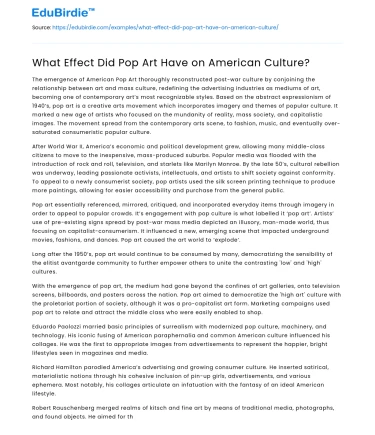The emergence of American Pop Art thoroughly reconstructed post-war culture by conjoining the relationship between art and mass culture, redefining the advertising industries as mediums of art, becoming one of contemporary art’s most recognizable styles. Based on the abstract expressionism of 1940’s, pop art is a creative arts movement which incorporates imagery and themes of popular culture. It marked a new age of artists who focused on the mundanity of reality, mass society, and capitalistic images. The movement spread from the contemporary arts scene, to fashion, music, and eventually over-saturated consumeristic popular culture.
After World War II, America’s economic and political development grew, allowing many middle-class citizens to move to the inexpensive, mass-produced suburbs. Popular media was flooded with the introduction of rock and roll, television, and starlets like Marilyn Monroe. By the late 50’s, cultural rebellion was underway, leading passionate activists, intellectuals, and artists to shift society against conformity. To appeal to a newly consumerist society, pop artists used the silk screen printing technique to produce more paintings, allowing for easier accessibility and purchase from the general public.
Save your time!
We can take care of your essay
- Proper editing and formatting
- Free revision, title page, and bibliography
- Flexible prices and money-back guarantee
Pop art essentially referenced, mirrored, critiqued, and incorporated everyday items through imagery in order to appeal to popular crowds. It’s engagement with pop culture is what labelled it ‘pop art’. Artists’ use of pre-existing signs spread by post-war mass media depicted an illusory, man-made world, thus focusing on capitalist-consumerism. It influenced a new, emerging scene that impacted underground movies, fashions, and dances. Pop art caused the art world to ‘explode’.
Long after the 1950’s, pop art would continue to be consumed by many, democratizing the sensibility of the elitist avantgarde community to further empower others to unite the contrasting 'low' and 'high' cultures.
With the emergence of pop art, the medium had gone beyond the confines of art galleries, onto television screens, billboards, and posters across the nation. Pop art aimed to democratize the 'high art' culture with the proletariat portion of society, although it was a pro-capitalist art form. Marketing campaigns used pop art to relate and attract the middle class who were easily enabled to shop.
Eduardo Paolozzi married basic principles of surrealism with modernized pop culture, machinery, and technology. His iconic fusing of American paraphernalia and common American culture influenced his collages. He was the first to appropriate images from advertisements to represent the happier, bright lifestyles seen in magazines and media.
Richard Hamilton parodied America’s advertising and growing consumer culture. He inserted satirical, materialistic notions through his cohesive inclusion of pin-up girls, advertisements, and various ephemera. Most notably, his collages articulate an infatuation with the fantasy of an ideal American lifestyle.
Robert Rauschenberg merged realms of kitsch and fine art by means of traditional media, photographs, and found objects. He aimed for the audience to have their own, individual interpretation of his art. He did this by combining his mediums at random; there was no predetermined arrangements or meanings as he produced each piece.
Jasper Johns used shredded newspaper, found objects, and mass-produced goods (i.e.: Ballantine Ale and Savarin Coffee cans), which erased the dichotomy of fine art and mass culture. He also used commonly known symbols like signs and flags as his main imagery. Each carried varied, subjective meanings, thus allowing each viewer the ability to understand the perceptual ambiguity before them.
One of the most famous pop artists, Andy Warhol, took the world by storm, forever impacting western commercial cultural. His personal branding immortalized him as the quintessence of pop art. Pieces like 'Campbell’s Soup Cans' and 'Marilyn Monroe' continue to receive consumer success and praise such like Monet’s and Van Gogh’s. Roy Lichtenstein remains as another acclaimed pop artist, aggressively using clear cut lines, bright primary colors, and focusing on simplicity. His work over simplified famed artists like Picasso and Mondrian in order to purposely subvert the original’s masterly precision to create a robust composition, 'less vulnerable to distortion'.
Pop art can still be seen today, gracing the covers of various music albums, influencing modern, contemporary art, and even used as a political statement. The art form remains as a well-known medium across the globe, standing as a pillar in educational art classes and continues to be one of the most iconic styles to date.
Pop art bridged the class gap between the realms of elite high art with mass cultures. The style introduced a new understanding of art; intelligent and readily comprehensible realism returned to society, providing viewers with identifiable themes drawn from everyday, common places.






 Stuck on your essay?
Stuck on your essay?

